Dog food obsession, a condition where a dog exhibits an excessive focus and behavior towards food, can become a significant concern for many pet owners.
This obsession goes beyond the normal appetite of a healthy dog, manifesting in behaviors such as constant begging, overeating, or even aggression around food.
Such behavior not only disrupts the household but can also lead to health issues, including obesity, nutritional imbalances, and related diseases.
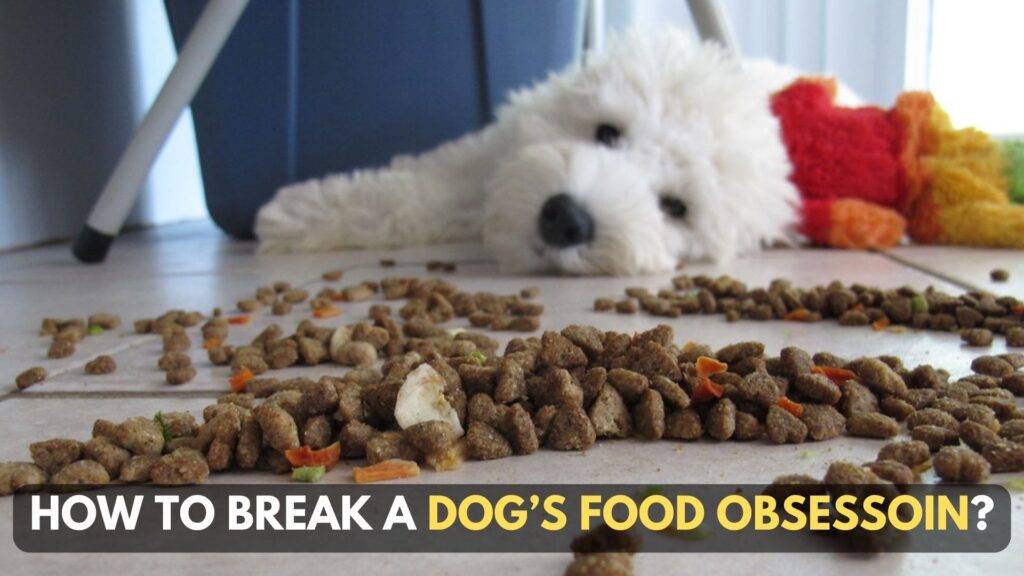
Addressing a dog’s food obsession is crucial not just for the sake of maintaining a peaceful home but, more importantly, for the health and well-being of the dog.
This article aims to delve into the roots of food obsession in dogs, identify the signs, and offer practical steps, expert tips, and answer some frequently asked questions to help owners manage or completely break their dog’s food obsession.
🥩🚫A Guide to Overcoming Dog Food Greed
Food obsession in dogs manifests as an overwhelming preoccupation with food, leading to behaviors that are both disruptive and potentially harmful.
Examples include a dog that whines or paces incessantly near feeding times, becomes aggressive when others approach its food, or scavenges constantly, even immediately after eating a full meal.
Common Reasons Why Dogs Develop Food Obsessions
- Psychological Factors: Just like humans, dogs can eat out of boredom, anxiety, or stress. These emotional states might drive a dog to seek comfort in food, leading to obsessive behaviors around eating.
- Health-related Issues: Sometimes, a dog’s food obsession stems from underlying health problems. Nutritional deficiencies, hormonal imbalances, or diseases like diabetes can increase a dog’s hunger and lead to obsessive food-seeking behaviors.
- Environmental Factors: The way a dog is fed can also contribute to food obsession. Inconsistent feeding schedules, free-feeding (leaving food out all the time), or using food as the primary form of affection can reinforce the dog’s preoccupation with food.
Signs of Food Obsession in Dogs
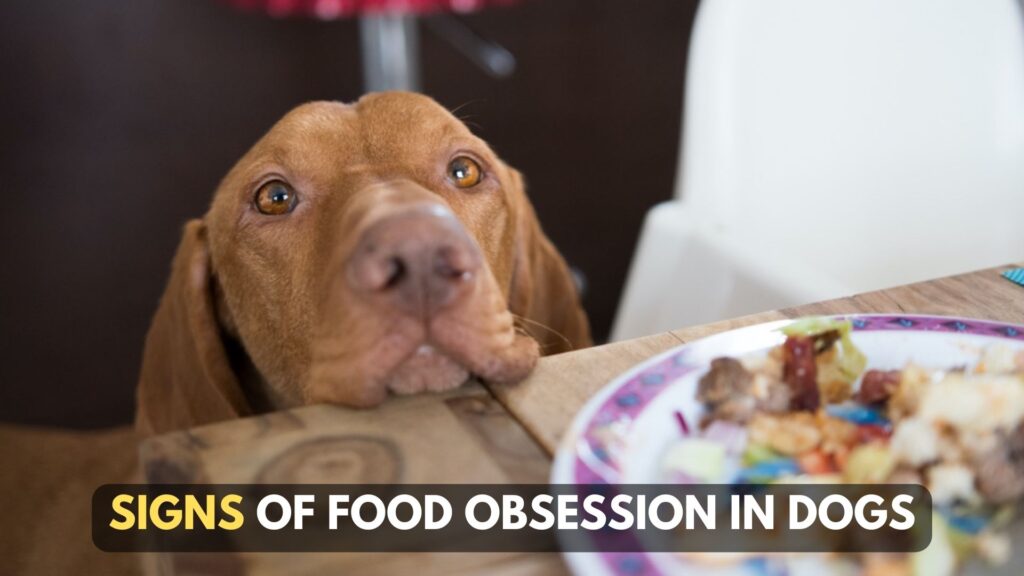
Recognizing the signs of food obsession early can help prevent the development of more serious health and behavioral issues.
Common signs include:
- Constant Begging: While many dogs look forward to mealtime, a dog with a food obsession may beg for food constantly, even shortly after eating.
- Aggression Around Food: Food-obsessed dogs might growl, snap, or bite if someone approaches them while they are eating or if they believe their food is being threatened.
- Stealing Food: A dog that frequently steals food off counters, from other pets, or even directly from people’s hands is exhibiting signs of food obsession.
- Overeating and Weight Issues: Dogs that obsess over food may eat too quickly, consume too much, or scavenge for additional food, leading to weight gain and associated health problems.
Understanding these foundational aspects of dog food obsession sets the stage for exploring strategies to manage and overcome this challenging behavior, ensuring your dog leads a healthy, balanced life.
🐕🦺 Expert Tips to Tackle Your Dog’s Overeating Problem
Preventing food obsession involves creating a healthy, structured environment around food. Here are key strategies to help prevent food obsession in dogs:
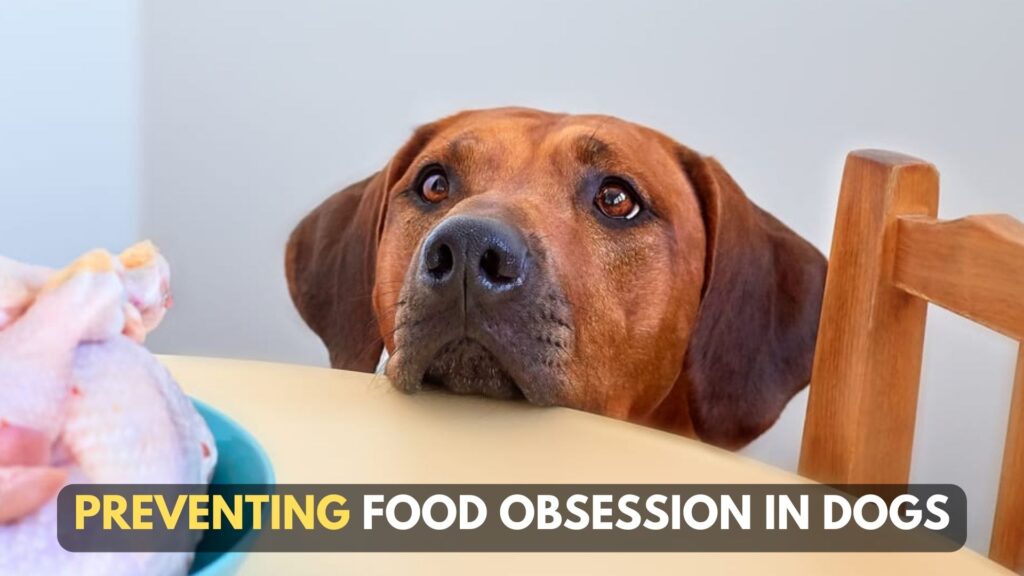
#1: Establishing a Regular Feeding Schedule
Creating and sticking to a consistent feeding schedule is crucial. Dogs thrive on routine, and knowing when to expect their next meal can reduce anxiety and obsession around food.
Aim to feed your dog at the same times every day to create a sense of security and predictability.
#2: Proper Portion Control and Measuring Meals
Overfeeding is a common contributor to food obsession and related health issues. Use measuring cups or scales to ensure you’re providing the correct amount of food according to your dog’s size, age, and activity level.
Consult your veterinarian to determine the ideal portion size for your dog.
#3: The Role of a Balanced Diet in Preventing Obsession
A balanced diet not only supports your dog’s overall health but can also prevent food obsession by satisfying nutritional needs. Ensure your dog’s diet includes the right balance of proteins, fats, carbohydrates, vitamins, and minerals.
Sometimes, food obsession stems from nutritional deficiencies, so a well-rounded diet can address underlying cravings. Consider incorporating high-fiber foods that can help your dog feel fuller longer, reducing the impulse to overeat.
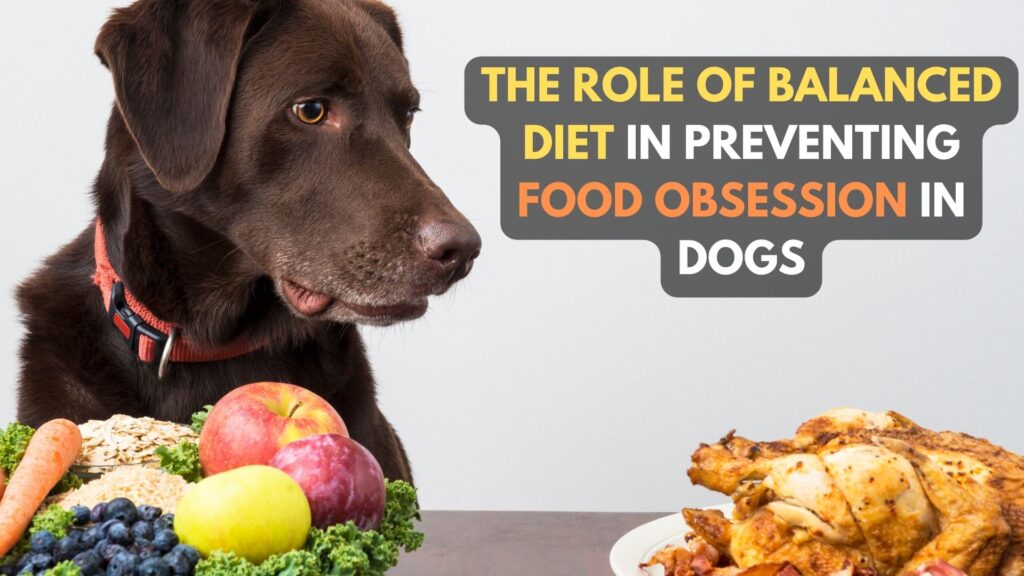
By understanding the signs of food obsession and implementing preventive strategies, you can help your dog develop a healthy relationship with food.
Establishing routines, ensuring proper nutrition, and fostering a positive feeding environment are key steps in preventing food-related issues.
Remember, if food obsession behaviors persist or if you suspect underlying health problems, consult a veterinarian or a professional dog behaviorist for further assistance.
Strategies to Break a Dog’s Food Obsession
#1: Training Techniques to Manage Begging and Food-Related Behaviors
Training plays a crucial role in addressing food obsession by teaching dogs self-control and appropriate behaviors around food.
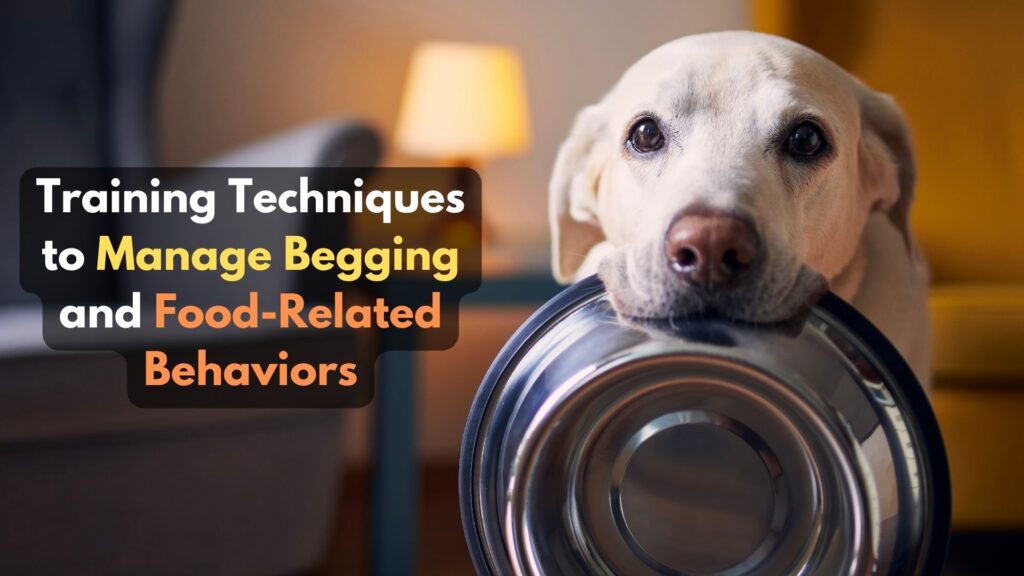
“Leave It” Command:
This command is invaluable in managing food obsession. It teaches dogs to ignore food unless given permission to eat. Start by holding a treat in your hand and closing your fist around it. When your dog tries to get it, say “leave it.”
Once they stop trying and move away, reward them with a different treat. Gradually increase the difficulty by placing the treat on the floor and covering it with your hand, then moving to not covering it at all.
Distraction Techniques:
When your dog starts showing signs of food obsession or begging, distract them with a toy, a game, or a short training session. This helps break their focus on food and reinforces alternative, positive behaviors.
#2: Importance of Exercise and Mental Stimulation
Physical exercise and mental stimulation are crucial in reducing food obsession. A well-exercised dog is less likely to focus obsessively on food, as their energy is directed towards healthy activities.

Incorporate daily walks, play sessions, and training exercises into your dog’s routine.
Puzzle toys and feeding toys that require effort to get food can also redirect their focus and provide mental stimulation.
#3: Consulting with a Vet or Animal Behaviorist for Tailored Advice
Each dog is unique, and what works for one might not work for another. If your dog’s food obsession is severe or if you’re struggling to manage it, consulting with a veterinarian or a certified animal behaviorist is recommended.

They can provide tailored advice based on your dog’s health, behavior, and specific needs, ensuring the strategies you implement are effective and safe.
Implementing Changes Gradually
Addressing food obsession is a process that requires time, patience, and consistency.
The Importance of Patience and Consistency:
Changing deeply ingrained behaviors won’t happen overnight. Be patient with your dog and consistent in applying the strategies you’ve chosen.
Consistency in commands, rewards, and routines helps reinforce the desired behaviors.
Tips for Introducing New Routines and Habits:
- Start small and gradually increase the complexity of tasks or commands.
- Use positive reinforcement to encourage desired behaviors, rewarding your dog with praise, pets, or treats (in moderation).
- Ensure all family members are on the same page to avoid confusing your dog with mixed messages.
Monitoring Progress and Adjusting Strategies as Needed:
Keep an eye on your dog’s response to the implemented changes. If certain strategies aren’t working, don’t hesitate to adjust your approach. Celebrate small victories and remain flexible in finding the best way to address your dog’s food obsession.
Breaking a dog’s food obsession involves a combination of training, lifestyle adjustments, and sometimes professional help.
By understanding your dog’s needs, applying these strategies with patience and consistency, and being willing to adjust your approach as needed, you can help your dog overcome food obsession.
This not only improves their health and well-being but also enhances the bond between you and your furry friend.
FAQs
What should I do if my dog becomes aggressive over food?
If your dog shows aggression over food, it’s crucial to address this behavior safely. Start by feeding your dog in a quiet, low-stress environment to reduce competition or threat perception.
Never try to take the food away while they’re eating, as this can increase aggression.
Instead, work on desensitization exercises, like adding more food to their bowl while they eat, to associate human presence with positive outcomes. If the aggression is severe, consult a professional dog trainer or behaviorist for targeted advice.
How can I stop my dog from stealing food?
Preventing access to food is the first step in stopping this behavior. Keep food out of reach and avoid leaving food unattended. Use training commands like “leave it” to teach self-control.
Consistently reinforce desired behaviors with positive rewards and ensure your dog is fed adequately and on a regular schedule to reduce the temptation to steal.
Is it okay to use treats in training if my dog is food obsessed?
Yes, treats can still be used in training, but it’s important to do so wisely. Opt for healthy, low-calorie treats and incorporate them into the dog’s daily calorie intake to prevent overfeeding.
Use treats sparingly and as part of a balanced training approach that also includes praise and toys as rewards.
How can I tell if my dog is eating enough or too much?
Monitor your dog’s weight and body condition regularly. A dog at a healthy weight should have a visible waist and you should be able to feel (but not see) their ribs under a thin layer of fat.
Consult your vet to determine the appropriate portion size based on your dog’s size, age, activity level, and health needs. Adjustments to food intake should be made based on changes in weight and activity.
Conclusion
Throughout this article, we’ve explored the multifaceted issue of dog food obsession, from recognizing the signs and understanding the causes to implementing strategies to break the obsession and prevent future issues.
Taking a proactive approach to managing your dog’s food obsession is crucial for their health, well-being, and the harmony of your home. Remember, the key to success lies in patience, consistency, and a willingness to adapt strategies as needed.
The benefits of addressing a dog’s food obsession extend beyond resolving the immediate behavioral issues, contributing to a happier, healthier life for both the dog and the owner.
If you encounter challenges along the way or if the obsession is linked to deeper health or behavioral issues, don’t hesitate to seek professional help from veterinarians or animal behaviorists.
Your commitment to understanding and supporting your dog through this challenge can significantly enhance the quality of your shared lives.


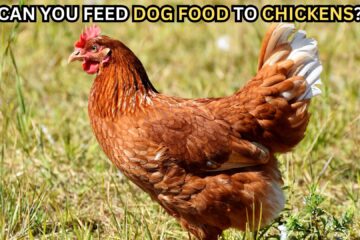
0 Comments